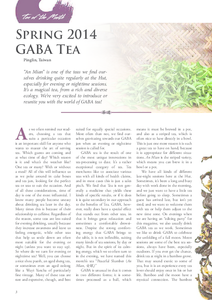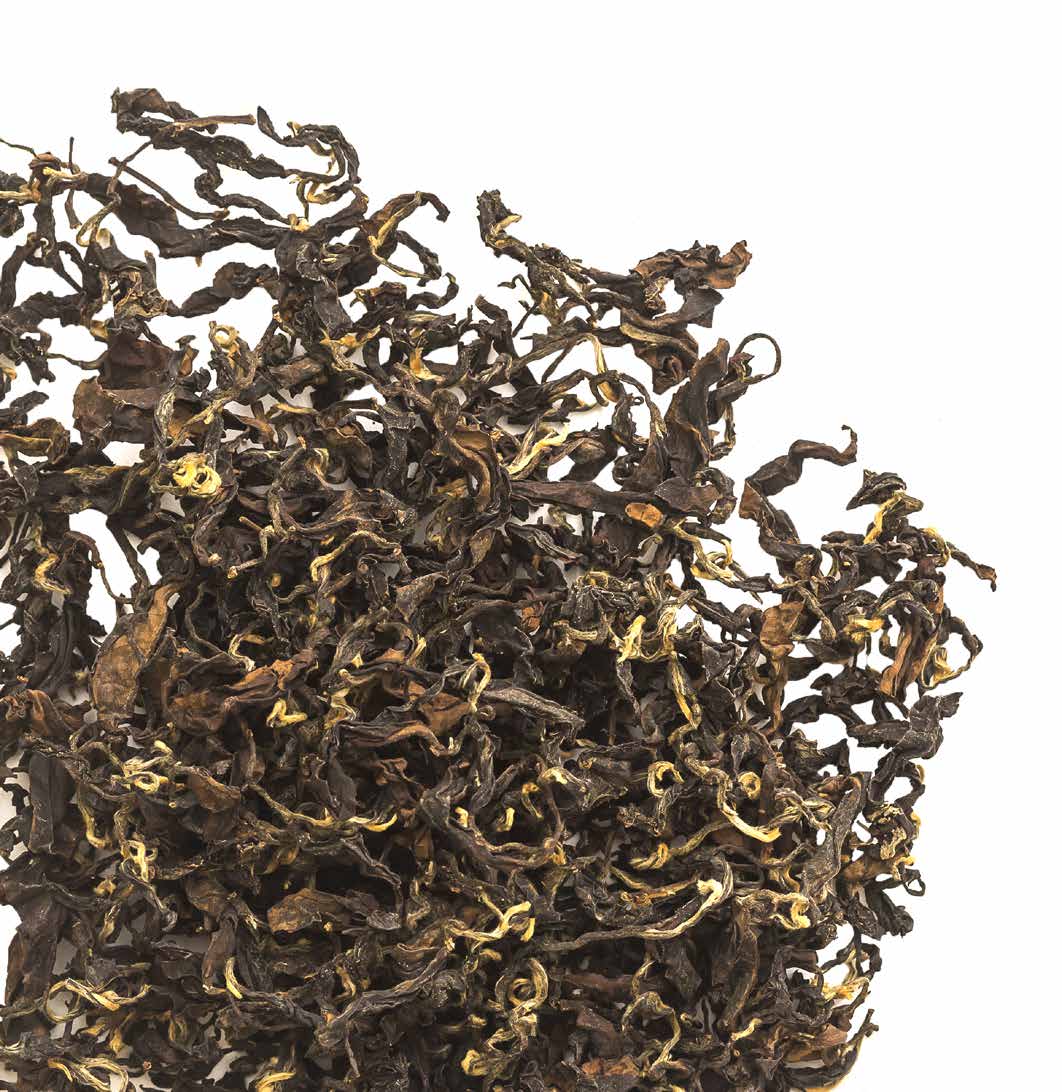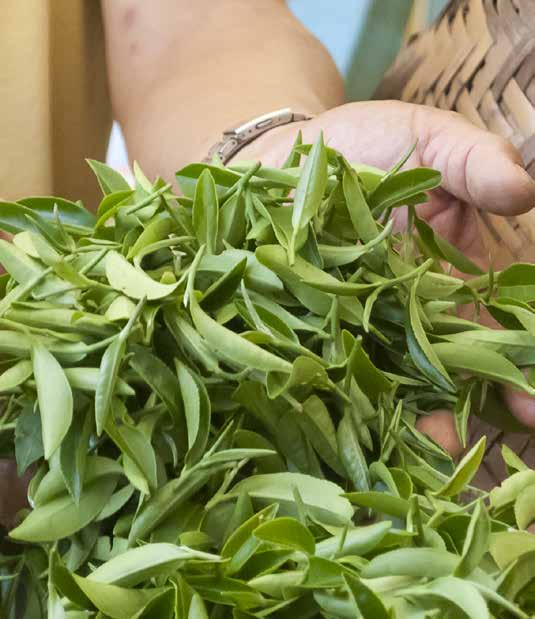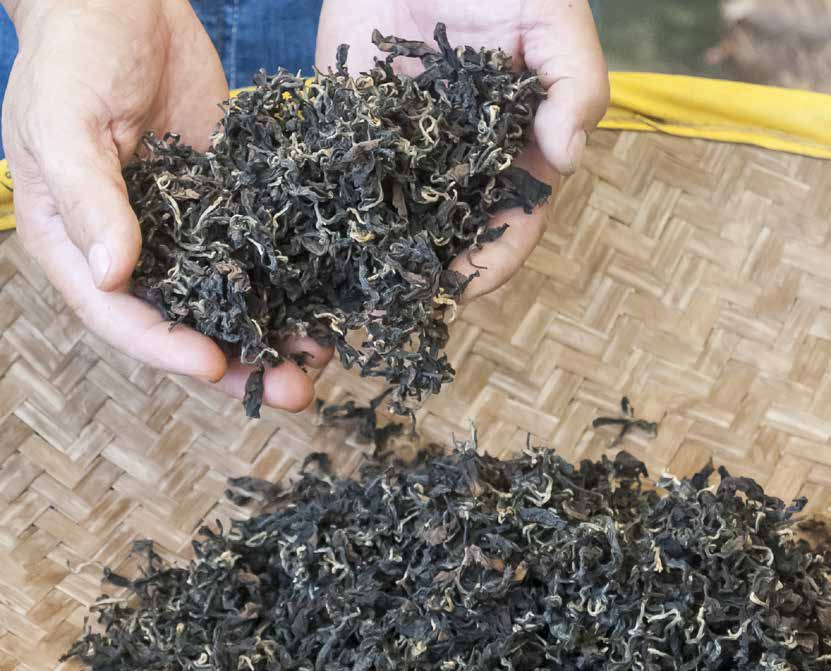
 |
|

As we often remind our readers, choosing a tea that suits a particular occasion is an important skill for anyone who wants to master the art of serving tea. Which guests are coming and at what time of day? Which season is it and what's the weather like? One tea or many? With or without a meal? All of this will influence us as we poke around in cake boxes and tea jars, looking for the perfect tea or teas to suit the occasion. And of all these considerations, time of day is one of the most influential. I know many people become uneasy about drinking tea later in the day. Many times this is because of their relationship to caffeine. Regardless of the reason, some teas are less suited for evening drinking, usually because they increase awareness and leave us feeling energetic, while other teas that help us settle down are often more suitable for the evening or night (unless you want to stay up). So where do we turn for evening or nighttime tea? Well, you can choose a nice shou puerh, an aged sheng tea, or sometimes even an aged oolong like a Wuyi Yancha of particularly fine vintage. Many of these teas are rare and expensive, though, and best suited for equally special occasions. More often than not, we find ourselves gravitating towards our GABA jars when an evening or nighttime session is called for.
GABA tea is the result of one of the most unique innovations in tea-processing to date. It's a rather exceptional category of tea. Tea merchants like to associate various teas with all kinds of health claims, and in most cases this is just a sales pitch. We find that Tea is not generally a medicine that yields these kinds of specific results, or if it does it is quite secondary in our approach to the benefits of Tea. GABA, however, really does have a special effect that stands out from other teas, in that it brings great relaxation and sometimes a comfortable drowsiness. Despite the strong comforting energy that GABA brings to the table, it is not inflexible, suiting many kinds of tea sessions, by day or night. But in the spirit of its calming energy, which we so often turn to in the evening, we have named this month's tea "Peaceful Slumber (An Mian, 安眠)"
GABA is unusual in that it comes in two different forms; it is sometimes processed as a ball, which means it must be brewed in a pot, and also as a striped tea, which is often nice to have directly in a bowl. This is just one more reason it is such a great tea to have on hand, because it is appropriate for different situations. An Mian is the striped variety, hich means you can brew it in a bowl or a pot.
We have all kinds of different late-night sessions here at the Hut. Sometimes, it's been a long and busy day with work done in the morning, and we just want to have a little tea before going to sleep. Sometimes a guest has arrived late, but isn't yet tired, and we want to welcome them with tea or help them adjust to the new time zone. On evenings when we are having an "editing party" for this magazine, we also usually drink GABA tea as we work. Sometimes we like to drink GABA to celebrate the unfolding of a full moon. Moon sessions are some of the best tea sessions, always have been, especially outdoors. If you ever get the chance, drink tea at night in a bamboo grove. That may sound exotic to some of you, but it is an experience every tea lover should enjoy once in his or her life. Bamboo and the moon have a mystical connection. The bamboo shines silver and sings to the moon, creaking and clacking in rhythms that stir the soul to a poetry that waxes like the moon above. Incidentally, we've already chosen a particular bamboo grove on our land to devote to nighttime sessions once we build the new center, Light Meets Life. We'll probably install a stone tea table there. And you're all invited to the first full moon session held there!
It is not necessary to drink GABA at night, and its effects are only very mild. It isn't an intoxicant. It's Tea, and She's gentle. Around here, we are very sensitive. As many of you know, at the center, we eat light, vegetarian meals, refrain from intoxicants and meditate every day. To us GABA seems very relaxing, indeed. And like all things Tea, a lot of the energy of the session is influenced by the one brewing, the environment and focus of the session as well as the energy of the tea itself.
One way to direct this energy so that it will fit the occasion is through the music you choose. If you choose something sonorous and quiet, without vocals, like a shakuhachi flute album, eyes grow heavy with sleep very soon and the tea session will gently lead everyone off to bed. When we have to work, like when editing these magazines, we invariably listen to our favorite jazz guitarist, Bill Frisell, whose music combined with the GABA leads us into a relaxed clarity and focus. For a celebratory session, we want to play something uplifting and light, so we can stay awake enough to enjoy one another's company, while the tea's sleepy energy will be waiting to find us after the session is over, allowing us to go to bed when we finish.
Some of the best tea sessions we've ever had were at night. There is a special magic when drinking tea during the full moon.

If you are lucky, and don't have anything planned for the next day, then it's great to stay up well into the night drinking a deep and powerful tea, like an aged puerh. But if you want to share in some of the magic nighttime energy without losing sleep, GABA is an excellent choice!
It is difficult to know in which category of tea GABA belongs. Oftentimes, GABA is listed as a kind of oolong tea, as it is primarily made from oolong varietals and is technically semi-oxidized, but the processing of GABA is so exceptional that categorizing it by varietal gets confusing. The Japanese usually make a less-oxidized version (though, as you'll soon see the ordinary term for withering, "oxidation", doesn't precisely apply to GABA), and from green tea tree varietals. In Taiwan, oolong varietals are used and the withering is heavier. Sometimes, the GABA tea made in Taiwan is so heavily oxidized that it more closely resembles red tea, further complicating the categorization of this unique tea. Maybe, like puerh, it deserves its own category.
GABA (Gamma Amino Butyric Acid) is a naturally-occurring substance in our bodies. It is one of the main neurotransmitters for the Central Nervous System. It works to prevent over-excitement of the nervous system. Decreased levels of GABA in the brain have been documented to have direct correlation to various disorders of the nervous system. GABA also affects the endocrine system, and some new research is showing an increase in beneficial hormones as a result of GABA consumption.
All tea actually contains GABA. The processing that has come to be known as "GABA" encourages this chemical greatly. A green tea has around five to seven milligrams of GABA per hundred grams, whereas a tea processed as "GABA" can have as much as 250 milligrams. One of the things we love the most about GABA is that it is almost always organic. Several farmers have told us that when inorganic tea is used, the amount of GABA is significantly lessened. We even saw some data proving this, where organic tea produced as much as 100 more milligrams of GABA than the inorganic alternative. When drinking GABA, it is therefore easy to tell if the tea is organic!
Though it's interesting to learn some of the science behind GABA, the experience is much more energetic for us. We aren't living as aggregates of chemicals, you and I. That isn't our experience. And there is always a limitation to tea information, and an infinity within a tea ceremony. We experience GABA not as a long, hard-to-pronounce chemical, but as a calming energy that feels like it supports and encourages sleep, without forcing you to sleep. There is that and all the aspects of its preparation, sharing and drinking that cannot be put into words...
The defining step in GABA processing is the withering, which is done in a complete vacuum. As most of you know, tea processing is distinguished most simply by degree of oxidation - green teas have little oxidation, oolongs range the middle spectrum of semi-oxidized teas, while red teas are more fully oxidized. GABA is withered, but it isn't oxidized. Sometimes, Nitrous Oxide is used in the withering of GABA, further sealing the tea in an oxygen-free space. An Mian was not produced in that way, though. It was withered in vacuum-sealed bags.
After picking, GABA does go through some oxidation. This is necessary for most all tea production, because some of the moisture has to evaporate from the leaves so that they are limp enough to be processed. Freshly-plucked tea leaves are full of water, and therefore brittle. Processing them in this form would cause them to break apart, as with any leaf. The most glaring exception is, of course, green tea, which was traditionally made exclusively from fresh and unopened buds, which means that they can be dried immediately after picking, and ideally with as little oxidation as possible. Nowadays, a lot of green tea is made with leaves and buds to increase yield, and has to have some oxidation as a result. But such teas are always inferior to the pure-bud green teas. Anyway, GABA is oxidized to a degree. This brief oxidation is another reason why GABA is usually thought of as an oolong tea. An Mian was oxidized until around 30% of the moisture content was released. This usually takes between one and two hours, depending on the weather, time of day and humidity.

After the initial withering, the key part of GABA processing begins: several switches from vacuum-sealed withering to tossing (lang chin), which separate and further oxidize the tea. Usually, these two steps are repeated three times. The tea withers in the oxygen-free bags for around eight hours and is then tossed for four hours - in a large tumbling machine, of course (imagine tossing tea by hand for four hours!). After withering and tossing/oxidizing for so long, the tea gets a short rest.
At this point, the tea goes through similar stages as most all oolong: it is fired to de-enzyme and arrest oxidation, called "sa chin", which literally translates to "kill-green" because this step kills green enzymes that make tea bitter. Then it is rolled, "ro nien", to further break down the cells and shape the tea. As we mentioned earlier, oolong tea can either be striped or ball-shaped. This is due to the type of rolling that occurs at this stage. We have GABA teas of both varieties, and like them both. An Mian is our favorite, though, and as we said, She is a striped variety. If the tea is to be ball-shaped, it is rolled in a twisted-up bag, whereas striped oolongs are rolled across bamboo mats with ribs on them to break down the cells.
After the de-enzyming and shaping/rolling, the tea is roasted dry. This is almost always done in two stages, and An Mian is no exception to that. A lot of oolong is roasted deeply and slowly to bring out the best flavors, and the farmers don't have time to do that while freshly-plucked leaves are coming in large volumes. For that reason, they give the tea a brief roast, called "zhou gan" to dry it and arrest the processing. Then, once all the tea is finished, they can roast it properly with the right focus and attention. An improper roast can completely ruin an oolong. This final roast is called "hong pei". Also, in the olden days, farmers often didn't roast their teas themselves. They would just zhou gan and then hand off this "rough tea (mao cha)" to merchants, shopkeepers or tea lovers who would then roast it to their taste or to suit their customer's tastes. Nowadays, that happens less often, though the best roast masters we know are, to this day, not farmers themselves!

One of the questions every tea lover gets asked more than any other is "Does this tea have caffeine?" After being asked this question hundreds of times, you begin to wonder what the question really means. Often, when you bounce the question back, politely responding: "Yes. What does that mean to you?" you find that for many people "caffeine" is a gremlin or a snark. They aren't sure exactly what it is, only that they read somewhere that you shouldn't intake too much. Other, better answers are based on personal experience, like "It upsets my stomach". We like those answers, as they are truth to that person and their body. Still, it's important to remember that caffeine is not an isolated molecule in Nature. It doesn't exist in or by itself (what does, actually?). In other words, the caffeine in chocolate is different than the caffeine in soda, which is different than the caffeine in tea. Furthermore, every single tea has different caffeine - every steeping, really! And the other chemicals in tea or chocolate interact with the caffeine and change its constitution and psychosomatic effects.
For us, the issue with seeing Tea as caffeine is that it reduces Tea (and us) to chemical aggregates. So much of the sensations, experiences and energies Tea evokes are beyond what any reductionistic study of its chemical constituents can elucidate. This is not to say that caffeine is not real, or that the stomachache you get when you take it is not real either. (We might also wonder what, if any, of these symptoms are caused by consuming the chemicals in inorganic teas.)
Wu De often relates that when he was in his freshman year of college and drinking coffee, he developed an allergy to "caffeine", which upset his prostate. But in decades of tea drinking, he has yet to experience the same discomfort. Obviously, Tea suits his constitution. The point, however, is that reducing Tea to "caffeine" unfortunately causes a lot of people to pass on a particular tea that not only would not have aggravated them in the way "caffeine" usually does, but might have been the impetus for spiritual insight. And we think that all these aspects of caffeine apply equally to the chemical aspect of GABA tea.
An Mian is grown in Pinglin, in northern Taiwan. It is produced by Yu San He, a great farmer and dear friend. Since this is the first time we have ever introduced him in Global Tea Hut, we've decided to devote a whole article to his story! (On pg. 11.) He's an incredible farmer, with a great attitude and a deep reverence for Nature. His tea is way beyond organic, with great biodiversity surrounding his lush trees. A lot of his trees are in the middle place between what we call "Living Tea" and organic plantation tea. Farms that fall into this middle ground are called "ecological gardens".

As we have discussed often in these pages, Living Tea comes with a problem: limited amount. If all tea were Living Tea, there wouldn't be enough tea for everyone in the world. We need some plantation tea. We have to compromise to increase yield so that everyone will have tea to share. But there is no compromise worth making in environmentally destructive tea production. Such tea does provide for everyone in space, but not in time. It isn't sustainable, in other words. Using agrochemicals does increase yield and produce larger quantities of tea, but it degrades the land and destroys the environment, so that future generations of tea lovers won't have any tea at all. And that isn't everyone! Consequently, one of Global Tea Hut's most important aims is to promote Living Tea or organic plantation tea. This doesn't just mean certified organic tea, but all clean tea - certified or not. (This month's tea is certified, by the way.)
It's nice, however, to see more tea gardens that are also falling into a kind of middle category. They aren't quite Living Tea, but some yield is sacrificed so that the trees can have a bit more space, grow up a bit taller and live amongst a bit more biodiversity. Such "ecological gardens" are a refreshing sign of all the influence that green, environmentally-friendly living is having on tea people in Asia and around the world wherever such tea is drunk!

We hope that you remember a bit about the tea varietals of Taiwan, which we covered in the August issue of Global Tea Hut. If not, take the time to look through that issue, as it is packed full of awesome information about Taiwanese tea - packed like old men pack their teapots here in Taiwan, so over-full that the lids are popping up and won't close! To review quickly, there are varietals of tea that were brought to Taiwan from Fujian long ago, and then some varietals that evolved specific to Taiwan. The greatest example of the former is "Ching Shin" or "Gentle Heart" oolong, while the paragon of the latter, Taiwanese varietals are the "Three Daughters of Taiwan": Kingfisher Jade (Tsui Yu), Golden Lily (Jing Shuan) and Four Seasons Spring (Si Ji Chun). Ching Shin is the most famous of Taiwanese oolong varietals, used to make most of the high mountain oolongs from central Taiwan.
Mr. Yu does have some Ching Shin trees, but they are too fragile and the yield is too little to use such tea for GABA production. He says that since the market in Taiwan has not yet taken to GABA tea, few to no farmers use Ching Shin to produce it. Also, he thinks a hardier, more resilient leaf is required. He thinks that Golden Lily (Jing Shuan) makes the best GABA and primarily uses that. However, the production of GABA is both expensive and time consuming, especially for a simple farmer like Mr. Yu who owns minimal equipment and must have the big bags of tea vacuum-sealed at another farm each time it is withering. For that reason, he only makes GABA when he has enough volume on hand. And that means that he sometimes has to blend in some Kingfisher Jade (Tsui Yu). Our tea of the month is such a blend. We actually like the batches that have some Tsui Yu better, as they seem deeper and more full-bodied.

An Mian is an amazing tea; it relaxes and soothes you in such a powerful way. GABA is a delightfully easy tea to brew, rewarding in unique flavors and aromas, with a relaxing Qi that has a dramatic effect on your physical relaxation. We hope that you enjoy sharing this beautiful tea with all of us around the world. Mr. Yu fully donated this month's tea, sharing it with joy and gratitude to all of you. He is very happy you will all be raising a bowl or cup of his tea this month!
Since this is a striped GABA, you can either put it in a bowl directly and add hot water or brew it in a pot and steep it. It is a very forgiving tea - you can't oversteep it or put too much. In fact, we like a strong bowl of GABA now and again. This tea is vibrant, from ecological gardens full of abundant biodiversity, and you can feel that in the bowl. Whether you use a pot or put the leaves right in a bowl, we'd say this is still more of a bowl tea, and recommend you drink it in that way.
Besides the gift, tea and magazine, this month actually comes with another wonderful addition we'd like to share with you and your loved ones: an evening or nighttime tea session! When was the last time you had one? If you are used to drinking tea in the daytime, there is a magic to an evening or even late night session. We therefore recommend that you use this month's tea as the perfect opportunity to invite someone you love to a late tea session. Pay attention to the differences in drinking at night.
GABA is the perfect tea to begin drinking in the evening, as it won't keep you up. In fact, most people sleep better after a bit of GABA. So choose a nice album, invite some good friends or family and share this month's tea one evening! Maybe you'll want to choose a weekend evening and make a night of it, or perhaps wait until the full moon and drink the tea then. If you can, why not have an outdoor session one evening, perhaps while watching the sunset? You could also meet somewhere special under the full moon and infuse your tea in moonlight as well as water. What an amazing month of Global Tea Hut it will be, as we all drink tea at night around the world! Let us know how it goes...

The moon shone bright, the night he called. We scoffed at sleep, popping off the lid. He giggled down in my jar, and promised to toast my Tea throughout the watches of the night. We took time to catch up, and reminisce old times, laughing and joking the steepings away. As the leaves unfurled, so did our words. But the bowls of silence said more, anyway... Soon he was snoring, the old coot! As for me, well, there's always morning Tea...- Wu De
